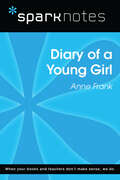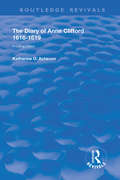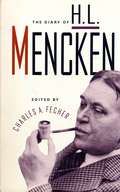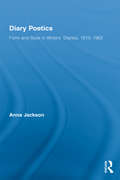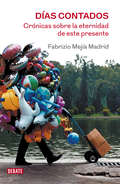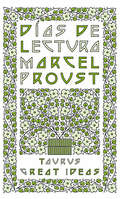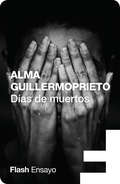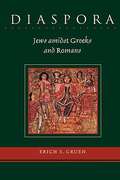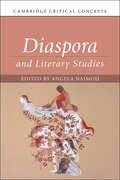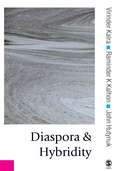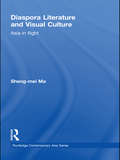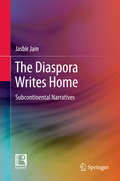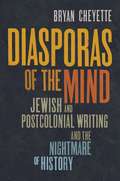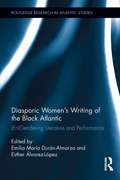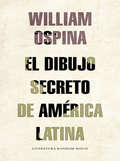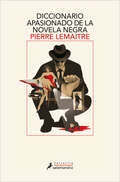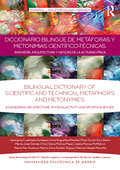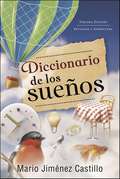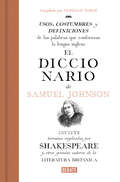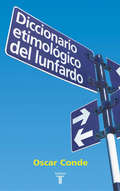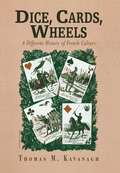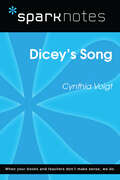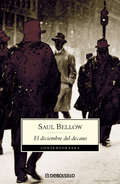- Table View
- List View
Diary of a Young Girl (SparkNotes Literature Guide Series)
by SparkNotesDiary of a Young Girl (SparkNotes Literature Guide) by Anne Frank Making the reading experience fun! Created by Harvard students for students everywhere, SparkNotes is a new breed of study guide: smarter, better, faster.Geared to what today's students need to know, SparkNotes provides:chapter-by-chapter analysis explanations of key themes, motifs, and symbols a review quiz and essay topics Lively and accessible, these guides are perfect for late-night studying and writing papers.
The Diary of Anne Clifford 1616-1619: A Critical Edition (Routledge Revivals)
by Katherine O. AchesonOriginally published in 1995, this book contains a full version of The Diary of Anne Clifford, alongisde an introduction and textual notes. Anne Clifford left one of the most extensive autobiographical records of the seventeenth century and, it was first published, this edition was the first critical edition of any of her works.
The Diary of H. L. Mencken
by Charles A. FecherA Historical Treasure: the never-before, published diary of the most outspoken, iconoclastic, ferociously articulate of American social critics -- the sui generis newspaperman, columnist for the Baltimore Sun, editor of The American Mercury, and author of The American Language, who was admired, feared, and famous for his merciless puncturing of smugness, his genius for deflating pomposity and pretense, his polemical brilliance. Walter Lippmann called him, in 1926, "the most powerful personal influence on this whole generation of educated Americans." H. L. Mencken's diary was, at his own request, kept sealed in the vaults of Baltimore's Enoch Pratt Library for a quarter of a century after his death. The diary covers the years 1930 -- 1948, and provides a vivid, unvarnished, sometimes shocking picture of Mencken himself, his world, and his friends and antagonists, from Theodore Dreiser, F. Scott Fitzgerald, Sinclair Lewis, and William Faulkner to Franklin D. Roosevelt, for whom Mencken nourished a hatred that resulted in spectacular and celebrated feats of invective. From the more than 2,000 pages of typescript that have now come to light, the Mencken scholar Charles A. Fecher has made a generous selection of entries carefully chosen to preserve the whole range, color, and impact of the diary. Here, full scale, is Mencken the unique observer and disturber of American society. And here too is Mencken the human being of wildly contradictory impulses: the skeptic who was prey to small superstitions, the dare-all warrior who was a hopeless hypochondriac, the loving husband and generous friend who was, alas, a bigot. Mencken emerges from these pages unretouched -- in all the often outrageous gadfly vitality that made him, at his brilliant best, so important to the intellectual fabric of American life.
The Diary of Lady Murasaki
by Murasaki Shikibu Richard BowringFrom the book: Murasaki Shikidu was born in Japan c. 973, during the Heian period (794-1192), when the head of the major faction of the Fujiwara clan, Michinaga, held sway over the imperial court. Her father was a minor official, who never became more than a provincial governor, and whose chief claim to fame must be his role in the education of his remarkable daughter. Apart from what she reveals in her diary, we know little of her life. She married around the turn of the century, had one daughter and was widowed soon after. During the next four or five years Murasaki seems to have begun writing The Tale of Genji, the work of fiction that was to bring her fame. It is probable that chapters were read at court and came to the notice of Michinaga, who decided that she would be an excellent addition to the entourage of his daughter, Shoshi (or sAkiko), the young emperors first consort. She entered the service of Shoshi in 1006. Her diary describes the details of court life, the birth of a prince, and contains some tart observations on her contemporaries, but the record as we have it today does not go beyond 1010. Lady Murasaki is best known as the author of the Genji, a long prose narrative of astonishing complexity and sophistication, which is today recognized as one of the masterpieces of Japanese literature. It is not known exactly how long she lived, but she probably died at some time between 1014 and 1025. Richard Bowring was educated at Downing College, Cambridge, from where he gained his PhD in 1973. He subsequently taught at Monash, Columbia and Princeton, returning to Cambridge in 1985. He is now Professor of Japanese Studies and Master of Selwyn College. He has written a number of books including Mori Ogai and the Modernization of Japanese Culture (1979) and An Introduction to Modem Japanese (2 volumes; 1992), and he was co-editor of The Cambridge Encyclopedia of Japan (1993). His primary research is now in the field of Japanese religions.
Diary Poetics: Form and Style in Writers� Diaries, 1915-1962 (Routledge Studies in Twentieth-Century Literature #12)
by Anna JacksonThe diary is a genre that is often thought of as virtually formless, a "capacious hold-all" for the writer’s thoughts, and as offering unmediated access to the diarist’s true self. Focusing on the diaries of Katherine Mansfield, Virginia Woolf, Antonia White, Joe Orton, John Cheever, and Sylvia Plath, this book looks at how six very different professional writers have approached the diary form with its particular demands and literary potential. As a sequence of separate entries the diary is made up of both gaps and continuities, and the different ways diarists negotiate these aspects of the diary form has radical effects on how their diaries represent both the world and the biographical self. The different published editions of the diaries by Katherine Mansfield, Virginia Woolf and Sylvia Plath show how editorial decisions can construct sometimes startlingly different biographical portraits. Yet all diaries are constructed, and all diary constructions depend on how the writer works with the diary form.
Días contados: Crónicas sobre la eternidad de este presente
by Fabrizio MejíaLas mejores historias de Fabrizio Mejía: trece crónicas, desde 1989 hasta 2010, que cubren desde la caída del Muro de Berlín hasta las «memorias de un dealer» en el DF. «Este libro es sobre el futuro. O, mejor, de cómo el presente se nos convirtió en una eternidad. Comienza en 1989 cuando se habló del fin de las ideologías y de la historia: ya todo se ha dicho, todo se ha hecho, somos los últimos. Fue una época muy narcisa: ningún futuro vendrá después de nosotros. Nos la presentaron como una teoría pero, en realidad, no pasó de ser una eternidad hechiza, pirata, falsa. Lo que siguió fue casi tan apasionante como la caída del Muro de Berlín (no se cayó, la gente lo tiró) porque los futuros posibles aparecieron por todos los rincones: místicos, recicladores, magos de la autoayuda, la disolución de la muerte, el Viagra, el socialismo caribeño que se negó a morir, la resistencia temporal, el exilio, las drogas, la red. Esta reunión de crónicas me habla ahora de esos futuros que probamos en veinte años sin encontrar uno que satisficiera a todos.» Fabrizio Mejía Madrid
Días de lectura (Serie Great Ideas #Volumen 5)
by Marcel ProustIdeas que han cambiado el mundo. A lo largo de la historia, algunos libros han cambiado el mundo. Han transformado la manera en que nos vemos a nosotros mismos y a los demás. Han inspirado el debate, la discordia, la guerra y la revolución. Han iluminado, indignado, provocado y consolado. Han enriquecido vidas, y también las han destruido. Taurus publica las obras de los grandes pensadores, pioneros, radicales y visionarios cuyas ideas sacudieron la civilización y nos impulsaron a ser quienes somos. En estos inspiradores ensayos sobre por qué leemos, Proust explora todos los placeres y padecimientos que ofrecen los libros, y explica además la belleza de Ruskin y su obra y el goce que supone perderse como niños en la literatura. Comentarios sobre la colección Great Ideas:«De veras que la edición es primorosa y pocas veces contenido y continente pueden encontrarse mejor ensamblados y unidos. ¡Qué portadas! Para enmarcar. [...] Ante las Great Ideas, solo cabe quitarse el sombrero. ¡Chapeau!»ABC «Taurus propone un doble envite con este lanzamiento. Por un lado aumenta su compromiso con el ensayo; por otro, recupera el gusto por la estética. A los volúmenes se les ha proporcionado una portada delicada y cuidada (copian el original británico) que invita a la lectura.»La Razón «Un fenómeno editorial.»The Guardian «Aparte de los contenidos, en general muy bien elegidos, son tan bonitos que si los ven seguro que cae alguno.»El País «Ideas revolucionarias, crónicas de exploraciones, pensamientos radicales... vuelven a la vida en estas cuidadísimas ediciones, muy atractivas para nuevos lectores.»Mujer Hoy «Grandes ideas bien envueltas. De Cicerón a Darwin, esta colección entra por los ojos.»Rolling Stone «Original y bella iniciativa la emprendida por Taurus con su colección Great Ideas.»Cambio 16 «Hay libros inmortales, libros únicos que contienen pensamientos y reflexiones capaces de cambiar el mundo, tesoros en miniatura reagrupados en la colección Great ideas.»Diario de León
Días de muertos
by Alma GuillermoprietoDos artículos de Alma Guillermoprieto, galardonada este año con el Premio Princesa de Asturias de Comunicación y Humanidades. Días de muertos y Un centenar de mujeres son dos textos recogidos en la antología Desde el país de nunca jamás, una colección de artículos de Alma Guillermoprieto publicados entre 1980 y 2008 en The Washington Post, The New Yorker y The New York Review of Books. A través de un minucioso y descarnado retrato, la periodista mexicana explora la compleja realidad de América Latina de los últimos años. Días de muertos es una reflexión sobre el impacto y corrosión que ha provocado el narcotráfico en la sociedad mexicana. La periodista se centra en la ciudad de Sinaloa como paradigma de la crisis en México; un reflejo de violencia, criminalidad y corrupción desatadas a raíz de la guerra de las drogas. El segundo texto, Un centenar de mujeres, es una crónica escalofriante escrita en 2003 sobre los feminicidios de Ciudad Juárez y Chihuahua. Guillermoprieto pone el foco en la historia de José Rayas, un importante líder sindicalista cuya hija de dieciséis años fue asesinada. El caso no fue suficientemente investigado y permanece rodeado de incógnitas. Rayas, al igual que la mayoría de familias afectadas por esta ola de feminicidios, nunca sabrá si se hizo justicia, si se investigó el asesinato en profundidad ni si se arrestó al verdadero asesino. A día de hoy, los crímenes de Ciudad Juárez aún continúan envueltos en la más absoluta impunidad. Sobre Desde el país de nunca jamás:«Magistral. América Latina ya tiene su Orwell.»David Remnick «Alma Guillermoprieto se enfrenta a la vida con un cuaderno y un bolígrafo en la mano. Es su forma de vida. Es su pasión. Y la disfruta con toda la intensidad posible.»Milenio «Su periodismo temerario, al igual que sus espléndidas descripciones y sus retratos de personajes, son fascinantes.»The Wall Street Journal «Una maravillosa lectura, repleta de humanidad, astucia, curiosidad y conocimiento.»The New York Times Book Review
Diaspora: Jews amidst Greeks and Romans
by Erich S. GruenThe book reminds us there was a time in history when there was no anti-Semitism. Its virulent strain only broke out in the terrible race riot in Alexandria of 38 CE, when the Romans were already ruling the city and the Jews and the Egyptians were vying for their favor--and their jobs. The author explores the lives of these Jews, the obstacles they encountered, the institutions they established, and their strategies for adjustment. He also delves into Jewish writing in this period.
Diaspora and Literary Studies (Cambridge Critical Concepts)
by Angela NaimouDiaspora is an ancient term that gained broad new significance in the twentieth century. At its simplest, diaspora refers to the geographic dispersion of a people from a common originary space to other sites. It pulls together ideas of people, movement, memory, and home, but also troubles them. In this volume, established and newer scholars provide fresh explorations of diaspora for twenty-first century literary studies. The volume re-examines major diaspora origin stories, theorizes diaspora through its conceptual intimacies and entanglements, and analyzes literary and visual-cultural texts to reimagine the genres, genders, and genealogies of diaspora. Literary mappings move across Africa, the Americas, Middle East, Asia, Europe, and Pacific Islands, and through Atlantic, Pacific, Mediterranean, Gulf, and Indian waters. Chapters reflect on diaspora as a key concept for migration, postcolonial, global comparative race, environmental, gender, and queer studies. The volume is thus an accessible and provocative account of diaspora as a vital resource for literary studies in a bordered world.
Diaspora & Hybridity (Published in association with Theory, Culture & Society)
by Virinder S. Kalra Raminder Kaur John Hutnyk'Diaspora & Hybridity deals with those theoretical issues which concern social theory and social change in the new millennium. The volume provides a refreshing, critical and illuminating analysis of concepts of diaspora and hybridity and their impact on multi-ethnic and multi-cultural societies' - Dr Rohit Barot, Department of Archaeology and Anthropology, University of Bristol What do we mean by 'diaspora' and 'hybridity'? Why are they pivotal concepts in contemporary debates on race, culture and society? This book is an exhaustive, politically inflected, assessment of the key debates on diaspora and hybridity. It relates the topics to contemporary social struggles and cultural contexts, providing the reader with a framework to evaluate and displace the key ideological arguments, theories and narratives deployed in culturalist academic circles today. The authors demonstrate how diaspora and hybridity serve as problematic tools, cutting across traditional boundaries of nations and groups, where trans-national spaces for a range of contested cultural, political and economic outcomes might arise. Wide ranging, richly illustrated and challenging, it will be of interest to students of cultural studies, sociology, ethnicity and nationalism.
Diaspora Literature and Visual Culture: Asia in Flight (Routledge Contemporary Asia Series)
by Sheng-mei MaThis book offers an incisive and ambitious critique of Asian Diaspora culture, looking specifically at literature and visual popular culture. Sheng-mei Ma’s engaging text discusses issues of self and its relationship with Asian Diaspora culture in the global twenty-first century. Using examples from Asia, Asian America, and Asian Diaspora from the West, the book weaves a narrative that challenges the twenty-first century triumphal discourse of Asia and argues that given the long shadow cast across modern film and literature, this upward mobility is inescapably escapist, a flight from itself; Asia’s stunning self-transformation is haunted by self-alienation. The chapters discuss a wealth of topics, including Asianness, Orientalism, and Asian American identity, drawing on a variety of pop culture sources from The Matrix Trilogy to Crouching Tiger, Hidden Dragon. This book forms an analysis of the new idea of Asian Diaspora that cuts across area, ethnicity, and nation, incorporating itself into the contemporary global culture whilst retaining a distinct Asian flavor. Covering the mediums of literature, film, and visual cultures, this book will be of immense interest to scholars and students of Asian studies and literature, ethnic studies, cultural studies, and film.
The Diaspora Writes Home
by Jasbir JainThe Diaspora Writes Home looks at the multiple dispersions of the emigrants from South Asia across time and space, to the various homelands they relate to now. The word 'write' is used in all its creative expression: as an inscription, a mark of connectivity, a remembrance, and an involvement with memory with all its shifts. Writing is also a representation and carries its own baggage of poetics and aesthetics, categories which can be problematic vis-a-vis the writer and his/her emotional location. The book explores the many ways the diaspora remembers and reflects upon the lost homeland and its own relationship with an ancestral past, its history, culture, and the current political conflicts. Among the questions the book asks is: How does the diaspora relate to us at home and what is our relationship to migrants as representatives of our present? The last is problematic in itself for our present is not theirs and distance cannot equate the two. The transformations that new locations have brought about as they have traveled through time and interacted with the politics of their new homelands have altered their affiliations and perspectives. An important aspect of political emigrations is the refugee/muhajir, especially in the South Asia subcontinent. [Subject: Literary Criticism, Asian Studies, Migration Studies]
Diasporas of the Mind
by Bryan CheyetteIn this fascinating and erudite book, Bryan Cheyette throws new light on a wide range of modern and contemporary writers--some at the heart of the canon, others more marginal--to explore the power and limitations of the diasporic imagination after the Second World War. Moving from early responses to the death camps and decolonization, through internationally prominent literature after the Second World War, the book culminates in fresh engagements with contemporary Jewish, post-ethnic, and postcolonial writers. Cheyette regards many of the twentieth- and twenty-first-century luminaries he examines--among them Hannah Arendt, Anita Desai, Frantz Fanon, Albert Memmi, Primo Levi, Caryl Phillips, Philip Roth, Salman Rushdie, Edward Said, Zadie Smith, and Muriel Spark--as critical exemplars of the diasporic imagination. Against the discrete disciplinary thinking of the academy, he elaborates and argues for a new comparative approach across Jewish and postcolonial histories and literatures. And in so doing, Cheyette illuminates the ways in which histories and cultures can be imagined across national and communal boundaries.
Diasporic Women's Writing of the Black Atlantic: (En)Gendering Literature and Performance
by Emilia María Durán-Almarza Esther Álvarez-LópezThis book brings together a complete set of approaches to works by female authors that articulate the black Atlantic in relation to the interplay of race, class, and gender. The chapters provide the grounds to (en)gender a more complex understanding of the scattered geographies of the African diaspora in the Atlantic basin. The variety of approaches displayed bears witness to the vitality of a field that, over the years, has become a diasporic formation itself as it incorporates critical insights and theoretical frameworks from multiple disciplines in the social sciences and the humanities, thus exposing the manifold character of (black) diasporic interconnections within and beyond the Atlantic. Focusing on a wide array of contemporary literary and performance texts by women writers and performers from diverse locations including the Caribbean, Canada, Africa, the US, and the UK, chapters visit genres such as performance art, the novel, science fiction, short stories, and music. For these purposes, the volume is organized around two significant dimensions of diasporas: on the one hand, the material—corporeal and spatial—locations where those displacements associated with travel and exile occur, and, on the other, the fluid environments and networks that connect distant places, cultures, and times. This collection explores the ways in which women of African descent shape the cultures and histories in the modern, colonial, and postcolonial Atlantic worlds.
El dibujo secreto de américa Latina
by William Ospina#Nuestra América es todavía el reino de la perplejidad,y a ello contribuyen por igual las tensiones y losdesajustes entre la realidad y el lenguaje, los mestizajesy los sincretismos. No deja de ser asombroso que estastierras ya su?cientemente complejas por su composicióngeográ?ca y biológica se hayan enriquecidomás aún con el aporte de razas, lenguas, tradiciones,religiones, ?losofías, modelos económicos e idealespolíticos llegados de otras partes. Pienso en Colombia,por ejemplo, donde no somos mayoritariamenteblancos europeos ni indios americanos ni negros africanossino uno de los países más mestizos del continente,en una región que es a la vez caribeña, de lacuenca del Pací?co, andina y amazónica, que hablauna lengua que es hija ilustre del latín y del griego,que profesa una religión de origen hebreo, griego yromano, que ha adoptado unas instituciones nacidasde la Ilustración y de la Revolución francesa, que fueincorporada al orden de la sociedad mercantil y a ladinámica de la globalización hace ya cinco siglos, ysiento que estamos amasados verdaderamente de laarcilla planetaria#.William Ospina
El dibujo secreto de américa Latina
by William OspinaAmérica Latina y su riqueza en palabras de William Ospina. #Nuestra América es todavía el reino de la perplejidad,y a ello contribuyen por igual las tensiones y losdesajustes entre la realidad y el lenguaje, los mestizajesy los sincretismos. No deja de ser asombroso que estastierras ya su?cientemente complejas por su composicióngeográ?ca y biológica se hayan enriquecidomás aún con el aporte de razas, lenguas, tradiciones,religiones, ?losofías, modelos económicos e idealespolíticos llegados de otras partes. Pienso en Colombia,por ejemplo, donde no somos mayoritariamenteblancos europeos ni indios americanos ni negros africanossino uno de los países más mestizos del continente,en una región que es a la vez caribeña, de lacuenca del Pací?co, andina y amazónica, que hablauna lengua que es hija ilustre del latín y del griego,que profesa una religión de origen hebreo, griego yromano, que ha adoptado unas instituciones nacidasde la Ilustración y de la Revolución francesa, que fueincorporada al orden de la sociedad mercantil y a ladinámica de la globalización hace ya cinco siglos, ysiento que estamos amasados verdaderamente de laarcilla planetaria#.William Ospina
Diccionario apasionado de la novela negra
by Pierre LemaitreUna visión completa, absolutamente personal y muy divertida del género negro, por uno de los escritores europeos más prestigiosos y populares. Se la llame negra o policiaca, y se la califique o no «literatura de género» --como si no fuera literatura sin más--, la novela criminal tiene súbditos, reyes, reinas (supuestos o no), capillas, polémicas, egos... pero, sobre todo, novelas que atrapan, impactan, sobrecogen y marcan tanto mentes como épocas. Incondicional de los libros, las películas y las series que describen --o denuncian-- la (mala) marcha del mundo, Pierre Lemaitre, con la libertad, el compromiso y la vivacidad que lo caracterizan, dibuja un panorama internacional personal y divertido, cual biblia erudita, ecléctica y festiva de la novela negra. La crítica ha dicho...«Con la ágil pluma que le conocemos, Pierre Lemaitre comparte en este Diccionario su pasión por la literatura policiaca y la novela negra con un subjetivismo entusiasta y razonado.»RTL «Pierre Lemaitre se apodera de la novela policiaca como novelista y lector, y ofrece su punto de vista con regocijo, asombro y placer. [...] Los aficionados a la novela negra disfrutarán enormemente con esta panorámica.»RTS culture «Uno de esos diccionarios por los que el lector se pasea a placer, antes de leerlo de cabo a rabo. Véanlo como una charla en torno al álbum de fotos de la familia o una invitación a descubrir todo lo que les quedaba por explorar en el continente del noir.»France Inter «Un libro imponente, rebosante de pasión por compartir, que alterna las declaraciones de amor con puyas muy sentidas. Una obra golosa que permite al aficionado, dependiendo de su apetito, devorarla o picar aquí y allá entre los retratos de escritores (de Eric Ambler a Don Winslow, pasando por Jean-Patrick Manchette, Elizabeth George, Donald Westlake y muchos otros) y las revisiones de personajes míticos (a Lemaitre le encanta Colombo), películas y series de referencia (Arresto preventivo, The Wire, etc.).»La Dépêche
Diccionario Bilingüe de Metáforas y Metonimias Científico-Técnicas: Ingeniería, Arquitectura y Ciencias de la Actividad Física
by Georgina Cuadrado EsclapezDiccionario Bilingüe de Metáforas y Metonimias Científico-Técnicas presents the extensive range of metaphoric and metonymic terms and expressions that are commonly used within the fields of science, engineering, architecture and sports science. Compiled by a team of linguists working across a range of technical schools within the Universidad Politécnica de Madrid, this practical dictionary fills a gap in the field of technical language and will be an indispensable reference for students within the fields of science, engineering or sports science seeking to work internationally and for translators and interpreters working in these specialist fields.
Diccionario de los Suenos
by Mario Jimv©nez CastilloConozca el significado de sus sueñosTercera edición revisada y aumentadaEl sueño es una función vital que aligera la carga energética, psicológica y psíquica del cerebro durante su estado consciente. Se calcula que el ser humano sueña entre cuarenta y cincuenta mil horas a lo largo de su existencia, algo así como una novena parte de su vida.En el Diccionario de los sueños encontrará una breve recopilación de las teorías que fundamentan el saber moderno sobre el proceso biológico, las características y los beneficios del sueño, así como más de ocho mil interpretaciones incluyendo palabras poco comunes no encontradas en otros diccionarios.Aprenda el simbolismo contenido en sus sueños y descifre los mensajes que le ayudarán a tomar decisiones importantes en la vida, reconocer oportunidades de trabajo, encontrar el amor y hasta prevenir enfermedades.Discover one of the most complete dream dictionaries, designed to help you decipher all of your dreams—from the simplest to the most abstract. This book presents more than 8,000 dream interpretations, including rare and uncommon words not found in other sources. (This is a Spanish-language book.)
El diccionario de Samuel Johnson: Usos, costumbres y definiciones de las palabras que conforman la lengua inglesa. Incluye términos que aparecen en Shakespeare y otros grandes autores de la literatura británica
by Gonzalo TornéUna cuidada selección de los artículos más irreverentes y emblemáticos del célebre Samuel Johnson. Samuel Johnson es, muy posiblemente, el literato inglés más importante del siglo XVIII y el autor más citado en su lengua hasta la fecha, solo después del gran Shakespeare. El diccionario de este ensayista, biógrafo y lexicógrafo no es solamente una obra de referencia, sino también una prodigiosa compilación de reflexiones. Ahora, Gonzalo Torné recupera en estas páginas los incisivos argumentos que revisten los artículos de Johnson, tan polémicos como expeditivos, que albergan la capacidad de desarbolar los más firmes discursos del más osado orador.
Diccionario etimológico del lunfardo
by Oscar CondeEdición corregida y aumentada. Este diccionario de lunfardo, con casi seis mil entradas, es el único que da cuenta de la etimología de los vocablos y resulta incomparable por su rigor científico, lo que redunda en una mayor claridad y facilita las búsquedas. La palabra lunfardo, que en su origen significó "ladrón" define un extenso vocabulario que nació en las ciudades rioplatenses y se extendió luego al resto del país y a las naciones limítrofes hasta instalarse definitivamente en nuestra habla cotidiana.Las palabras que usamos son mucho más que un medio de comunicación: en su conjunto reflejan un modo de ver el mundo, de categorizar la realidad, de entenderla, en suma, de vivirla. Y sólo nacen cuando el hablante no tiene otras mejores para expresar lo que quiere decir. Los lunfardismos no escapan a esta ley, y constituyen un potente caudal que enriquece nuestro idioma y contribuye de manera indiscutible a construir nuestra identidad. La presente edición, corregida y aumentada, incorpora nuevas acepciones de términos ya registrados y añade voces que no contaban con registro hasta la fecha, como cachengue, ladri, roche, tarlipes y viejazo, entre otras.
Dice, Cards, Wheels
by Thomas M. KavanaghGambling has been a practice central to many cultures throughout history. In Dice, Cards, Wheels, Thomas M. Kavanagh scrutinizes the changing face of the gambler in France over a period of eight centuries, using gambling and its representations in literature as a lens through which to observe French culture. Kavanagh argues that the way people gamble tells us something otherwise unrecognized about the values, conflicts, and cultures that define a period or class. To gamble is to enter a world traced out by the rules and protocols of the game the gambler plays. That world may be an alternative to the established order, but the shape and structure of the game reveal indirectly hidden tensions, fears, and prohibitions.Drawing on literature from the Middle Ages to the present, Kavanagh reconstructs the figure of the gambler and his evolving personae. He examines, among other examples, Bodel's dicing in a twelfth-century tavern for the conversion of the Muslim world; Pascal's post-Reformation redefinition of salvation as the gambler's prize; the aristocratic libertine's celebration of the bluff; and Balzac's, Barbey d'Aurevilly's, and Bourget's nineteenth-century revisions of the gambler.Dice, Cards, Wheels embraces the tremendous breadth of French history and emerges as a broad-ranging study of the different forms of gambling, from the dice games of the Middle Ages to the digital slot machines of the twenty-first century, and what those games tell us about French culture and history.
Dicey's Song (SparkNotes Literature Guide Series)
by SparkNotesDicey's Song (SparkNotes Literature Guide) by Cynthia Voigt Making the reading experience fun! Created by Harvard students for students everywhere, SparkNotes is a new breed of study guide: smarter, better, faster.Geared to what today's students need to know, SparkNotes provides:chapter-by-chapter analysis explanations of key themes, motifs, and symbols a review quiz and essay topics Lively and accessible, these guides are perfect for late-night studying and writing papers.
El diciembre del decano
by Saul BellowAlbert Corde, decano de la facultad de periodismo de Chicago, no está preparado para la violenta respuesta social que han tenido sus artículos sobre la corrupción imperante en la ciudad o su enredo en el proceso contra dos negros sospechosos del asesinato de un estudiante blanco. Acusado de traicionar a su ciudad, de ser un loco incívico y un racista, durante un viaje que le lleva a Bucarest, donde su suegra agoniza, Corde no puede evitar establecer severas comparaciones entre la corrupción y la deshumanización de la tiranía comunista, y las putrefactas y abandonadas calles de Chicago. Mediante la yuxtaposición de diferentes acontecimientos -tanto públicos como privados- que se suceden simultáneamente en ambas ciudades, Bellow ilustra hábilmente cómo el remolino de fuerzas que sacude al hombre contemporáneo puede reunirse para provocar su fracaso.
